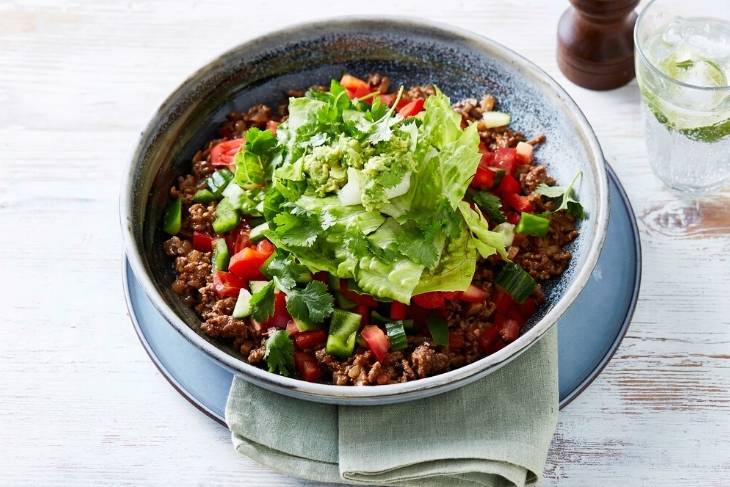How to eat well for less

If you feel like it’s more expensive than ever to shop for food, you’re not imagining it. Research shows that a basket of 21 typical grocery items costs $45 more in 2024 than it did two years ago.
It’s probably not too surprising then, that according to a recent survey by consumer group CHOICE, 87 per cent of Australian households are concerned about food costs. In fact, a different survey shows that two out of three people in Australia say that in the current cost of living crisis, its grocery prices that’s their biggest ongoing financial concern.
If that’s left you wondering how to maintain a nutritious diet, the good news is there are a number of things you can do to create healthy, budget-friendly meals. Here are 14 tips that will help you eat well for less.
1. Shop for seasonally available food
Eating fruits and vegetables when they’re in season gives you the benefit of their full flavour, freshness and nutritional value. You will also drastically reduce your weekly spending as in-season produce is much cheaper.
Compared to packaged and ultra-processed foods, fruit and vegetables will always deliver the biggest bang for your buck nutrition wise, and when they’re in season, they’re significantly cheaper, too. So choosing recipes that are based around seasonal produce when you’re in your meal-planning phase is savvy.
Not sure what foods are in season and when? Read our blog on how to buy the best fresh produce.
2. Use affordable sources of meat and fish
From maintaining muscle mass to improved appetite control, fewer food cravings and a reduced energy intake, diets that are higher in protein, like the CSIRO Total Wellbeing Diet, have many benefits. But, while meat can be one of the most expensive grocery items, there are affordable ways to maintain your protein intake. Choose recipes that use canned fish or cheaper cuts of meat and look at getting cheaper cuts such as chuck steaks for stews.
Frozen fish and salmon are generally cheaper than fresh seafood, and it can sometimes be cheaper to buy a whole chicken rather than chicken fillets.
3. Bulk up your meals with plant-based protein
While some research shows diets that are 100 per cent plant based decrease food costs by at least 16 per cent, simply switching out some meat-based meals for plant-based ones will be beneficial for your budget. In fact, Australian research shows that following a Mediterranean diet, which is heavily but not solely plant based, saves a family of four at least $28 a week compared to the typical Western diet.
Use eggs, beans, lentils, or tofu in place of some meat portions at dinner to help cut your grocery bill. Our protein balance philosophy recommends eating at least 25 g at each meal and around 100 g of protein each day.
For advice on the best vegetarian protein options, click here.
4. Batch cook your meals and use leftovers
Batch cooking meals, or making more portions than you need, allows you to cook a healthy meal once, eat twice – or more, depending on how much food you make.
The beauty of this as a cost-saving tactic means you can bulk buy ingredients, which can be cheaper as a result. And, with a healthy meal waiting for you in the fridge, you can avoid impulse buying something when you’re short on time.
5. Use what you have
When you’re in meal-planning mode, do a stocktake of your pantry, fridge and freezer and choose recipes which take advantage of the ingredients you already have. This not only saves money by avoiding food waste (more on that later!), it can also make your weekly grocery shop less expensive.
6. Try supermarket own brands
Next time you’re replacing pantry staples like beans, tomato sauce, yoghurt, tinned goods, and canned fish, try looking for the supermarket's own brand. These often sell for a fraction of the price of the market leader and taste just as delicious. Making the switch to as many of those as possible can shave up to 40 per cent from your grocery bill.
7. Spread your shop around
Instead of sticking to the same supermarket to do your grocery shop, visit and buy from different ones, depending on which has the best deals at the time. Doing this can cut up to 20 per cent from your grocery bill. And don’t forget Aldi – CHOICE’s most recent grocery basket survey found shopping there could cost 25 per cent less on a basket of 14 common grocery items.
8. Buy canned or frozen fruit and vegetables
If you find yourself throwing out fruit and vegetables because you haven’t got to them in time, consider whether frozen versions might be a more cost-effective option for you. Most frozen fruit and veggies are snap frozen, which seals in the nutrients and makes them just as healthy as their fresh counterparts. You’ll also save on price.
On average, buying canned or frozen produce is around $11 per kilogram cheaper than fresh equivalents, but for some items the savings can be significantly higher. When buying canned fruit, choose products in natural juice rather than syrup and look for canned vegetables that contain no more than 400mg, but ideally less than 120mg, of sodium per 100g.
If you want to stick to fresh foods, learn what will stay fresh and nutritious in the fridge or cupboard, and for how long.
9. Shop with a list
And consider shopping with that list, online. While research shows that shopping for food with an itemised list saves money, buying groceries online could save you more than $1300 a year thanks to how it limits impulse purchases.
10. Consider the unit price
Using unit pricing – for example the price per 100g – is a much more effective way to compare prices for grocery products, to find the best value for money. Proof is the fact that when unit pricing isn’t available, 40 per cent of shoppers aren’t able to identify the best-value deal.
11. Ditch the café breakfasts
You can easily prepare avocado on toast or an omelette at home for a fraction of the price of what you would pay at a café. Buying a loaf of bread, a couple of avocados and a carton of eggs will make you a week’s worth of breakfasts, rather than a costly one-off meal.
12. Avoid jumping on superfood fads
The popularity of what’s considered a superfood can really bump up costs. Try to avoid jumping on the hype and instead focus on minimally processed whole foods, such as almonds over activated almonds.
13. Use your freezer
If it turns out you won’t get a chance to eat that extra batch-cooked meal or leftovers, don’t let them languish in your fridge until they’re too old to eat. Freeze them for later in an airtight container to prevent freezer burn.
14. Be smart about how you store fresh food
This can extend its shelf-life, giving you more opportunity to use and eat it rather than it winding up in the bin. A few helpful tips include avoiding overcrowding your fridge and using your crispers wisely. Generally speaking, veggies that wilt easily will last longer in higher humidity and fruit that rots easily needs lower humidity.
The CSIRO Total Wellbeing Diet
We know that eating on a budget can be challenging, which is why we created a ‘Simple’ menu plan for members.
This plan follows the much-loved higher protein, low GI philosophy of our other plans, but features many no-cook meals that are quick to prepare and cost less too, but still taste great!
It is scientifically designed for weight loss and the benefit is tasty, healthy meals and a happier, healthier body.
Learn more about our meal plans.
Cheapest healthy meals
Here are some of our delicious and healthy CSIRO Total Wellbeing Diet recipes for weight loss on a budget!
• Thai-style beef and bean stir-fry
For more delicious CSIRO Total Wellbeing Diet recipes, click here

